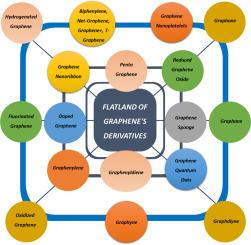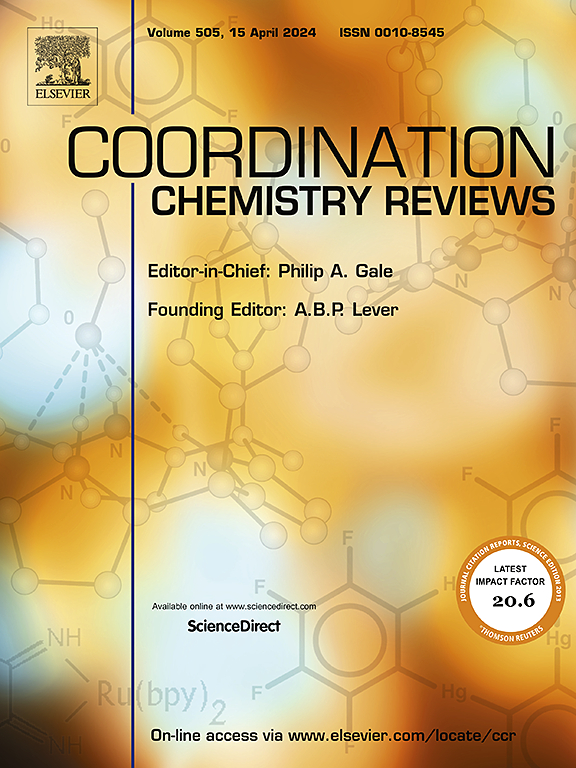石墨烯衍生物的分类、合成、机理、缺陷的作用、应用和展望
IF 20.3
1区 化学
Q1 CHEMISTRY, INORGANIC & NUCLEAR
引用次数: 0
摘要
本文综述了氢化石墨烯、氟化石墨烯、氧化石墨烯、石墨炔、石墨炔、石墨烯、石墨烯、石墨烯、石墨烯纳米片、GQDs、石墨烯海绵、RGO、石墨烯纳米带、掺杂石墨烯、五烯石墨烯、石墨烯、石墨烯二烯、联苯、净石墨烯、石墨烯+和t-石墨烯纳米带的发展历史、合成策略、机理。缺陷影响石墨烯衍生物质量的关键作用,以及应用和前景。这些衍生物,从氢化和氟化石墨烯到掺杂石墨烯和石墨烯,表现出不同的性质和应用。然后,我们的重点转移到所采用的合成技术,提供对形成这些衍生物的方法的见解。随后对缺陷的分析,包括点缺陷、空位、晶界等,突出了影响其特性的复杂性。此外,我们还使用先进的光谱技术,如紫外、扫描电子显微镜、x射线光电子、拉曼等,详细回顾了石墨烯衍生物的缺陷形貌。此外,本文还重点介绍了它们对材料性能、缺陷后果的深远影响以及在不同生活时代的潜在应用。这些应用涵盖了不同的领域,包括生物传感器、人工智能、军事防御、太阳能和海水淡化。此外,本文还对这一动态领域的未来研究轨迹进行了展望,为研究界进一步释放石墨烯衍生物在多学科领域的潜力提供了路线图。本文章由计算机程序翻译,如有差异,请以英文原文为准。


Flatland of Graphene's derivatives: Classification, synthesis, mechanisms, role of defects, applications, and prospectives
This comprehensive review explores the fantasy flatland of derivatives of graphene composes of hydrogenated graphene, fluorinated graphene, oxidized graphene, graphyne, graphdiyne, graphane, graphone, graphene nanoplatelets, GQDs, graphene sponge, RGO, graphene nanoribbon, doped graphene, penta graphene, graphenylene, graphenyldiene, biphenylene, net-Graphene, graphene+, and T-graphene based nanoribbons, their history, synthesis strategies, mechanism, the pivotal role of defects that affect the quality of graphene's derivatives, as well as applications and prospects. The derivatives, spanning from hydrogenated and fluorinated graphene to doped graphene and graphenylene, exhibit distinct properties and applications. Our focus then moves to the synthesis techniques employed, providing insights into the methodologies shaping these derivatives. The subsequent analysis of defects, including point defects, vacancies, grain boundaries, and more, highlights the complexities influencing their characteristics. Moreover, we present a detailed review of defective morphologies of the derivatives of graphene using advanced spectroscopy techniques such as ultraviolet, scanning electron microscopy, X-ray photoelectron, Raman, etc. Besides, this review also highlights their profound influence on material properties, defect consequence, and potential applications useful in different eras of life. These applications span diverse fields, including biosensors, artificial intelligence, military defense, solar energy, and water desalination. In addition, perspectives on the future trajectory of research in this dynamic field are provided, offering a roadmap for the research community to further unlock the potential of graphene derivatives in multidisciplinary fields.
求助全文
通过发布文献求助,成功后即可免费获取论文全文。
去求助
来源期刊

Coordination Chemistry Reviews
化学-无机化学与核化学
CiteScore
34.30
自引率
5.30%
发文量
457
审稿时长
54 days
期刊介绍:
Coordination Chemistry Reviews offers rapid publication of review articles on current and significant topics in coordination chemistry, encompassing organometallic, supramolecular, theoretical, and bioinorganic chemistry. It also covers catalysis, materials chemistry, and metal-organic frameworks from a coordination chemistry perspective. Reviews summarize recent developments or discuss specific techniques, welcoming contributions from both established and emerging researchers.
The journal releases special issues on timely subjects, including those featuring contributions from specific regions or conferences. Occasional full-length book articles are also featured. Additionally, special volumes cover annual reviews of main group chemistry, transition metal group chemistry, and organometallic chemistry. These comprehensive reviews are vital resources for those engaged in coordination chemistry, further establishing Coordination Chemistry Reviews as a hub for insightful surveys in inorganic and physical inorganic chemistry.
 求助内容:
求助内容: 应助结果提醒方式:
应助结果提醒方式:


